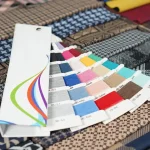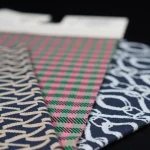
A New Trend in Fashion Design: Recycled Yarns
6 May 2025
The Key to Sustainable Fashion: The Use of Regenerated Yarn
10 May 2025As sustainability becomes increasingly important in the textile industry, recycled yarns are becoming the foundational elements of the circular economy. This article examines the production processes, role in circular systems, and innovative strategies of Seryaman Textile in this field. Beyond environmental gains, recycled yarns also generate economic and social value, contributing significantly to the sustainable future of the textile sector.
As sustainability gains increasing importance in the textile industry, recycled yarns have become one of the cornerstones of the circular economy. While traditional textile production models operate on a “take-make-dispose” principle, the circular economy approach promotes the continuous reuse and revaluation of resources. Recycled yarns are one of the most tangible examples of this model within the textile sector. Especially manufacturers like Seryaman Textile, which place sustainability at the core, lead pioneering efforts in this field.
This article explores the role of recycled yarns in the circular economy, their production processes, and their environmental and economic benefits in detail. It also highlights the innovative approaches of Seryaman Textile in recycled yarn production and how these yarns contribute to the sustainable future of the textile industry. Readers will learn how choosing recycled yarns supports the circular economy and helps reduce environmental impact.
The Circular Economy Model and the Textile Industry
Unlike linear economies, the circular economy aims for the repeated use of resources and the minimization of waste. The textile sector, known for high resource consumption and waste production, holds significant potential for transitioning to a circular model. Traditional textile production generally follows a linear path involving raw material extraction, processing, manufacturing, consumption, and waste.
In contrast, the circular textile economy seeks to create value at every stage of a product’s life cycle. For instance, used garments can be worn again, repaired, or transformed into new products. When that’s not possible, they can be broken down into fibers to produce new yarns. Thus, recycled yarns are at the heart of the circular textile economy, turning textile waste into valuable resources.
The Production Journey of Recycled Yarns
 The production of recycled yarns begins with the collection of textile waste and proceeds through several processes to create new yarns. Seryaman Textile uses advanced technology and sustainable methods to produce high-quality recycled yarns throughout this journey.
The production of recycled yarns begins with the collection of textile waste and proceeds through several processes to create new yarns. Seryaman Textile uses advanced technology and sustainable methods to produce high-quality recycled yarns throughout this journey.
The production process generally includes the following steps:
• Collection and Sorting: Textile waste is separated by color, composition, and quality. This step is critical for the final product’s quality.
• Mechanical Processing: The waste is shredded into smaller pieces and opened back into fibers. These fibers are then cleaned and impurities removed.
• Yarn Formation: The cleaned fibers are combed, drawn, and spun into yarns. Seryaman Textile uses open-end (rotor) yarn technology to produce yarns ranging from 6/1 to 30/1 in count.
Notably, Seryaman Textile achieves up to 95% water savings compared to conventional yarn production. At the same time, chemical use is minimized, significantly reducing environmental impact.
The Critical Role of Recycled Yarns in Circular Economy
Recycled yarns play a vital role in the success of the circular economy. By transforming waste flows into valuable resources, they close the loop and greatly contribute to the sustainability of the textile industry.
Functions of recycled yarns in the circular economy include:
• Resource Efficiency: Recycled yarns reduce the need for new raw materials. The land, water, and pesticides used for cotton cultivation are significantly lowered, leading to more efficient use of natural resources.
• Waste Reduction: Instead of being sent to landfills, textile waste is turned into valuable input. This not only prevents pollution but also lowers waste management costs.
• Energy Savings: Producing recycled yarns requires less energy than conventional yarns. For instance, recycled polyester yarn production can save up to 50% energy compared to virgin polyester.
Seryaman Textile’s Contribution to Circular Economy
Seryaman Textile significantly contributes to the circular economy with its innovative approaches in recycled yarn production. The company places sustainability at the heart of its business model, offering solutions to reduce the environmental impact of the textile industry.
Key contributions include:
• Expanded Product Range: The company offers yarns made from recycled cotton and polyester in a variety of counts and more than 99 color options, making sustainable products more accessible.
• Integrated Production Model: By also producing knitted fabrics from recycled yarns, Seryaman Textile unifies various stages of the circular economy under one roof, helping to reduce carbon emissions in logistics processes.
• Innovation and R&D: The company conducts continuous research and development to improve the quality and applications of recycled yarns, thus strengthening the technological infrastructure of the circular economy.
Economic and Social Impact of Recycled Yarns
 Beyond environmental benefits, recycled yarns also bring significant economic and social impacts. These yarns provide cost efficiency while creating new job opportunities and social value.
Beyond environmental benefits, recycled yarns also bring significant economic and social impacts. These yarns provide cost efficiency while creating new job opportunities and social value.
Economically, recycled yarns can lower raw material costs and optimize production. Especially during periods of volatile raw material prices, they offer a more stable cost structure. Additionally, collection, sorting, and processing of waste create new employment opportunities that support local economies.
Socially, recycled yarns help raise consumer awareness of sustainability. Brands can support corporate social responsibility goals and enhance their value by using products made from recycled yarns. Moreover, these yarns can contribute to improving working conditions within the textile industry.
Looking Ahead: The Future of Recycled Yarn Technologies
In the future of the textile industry, recycled yarn technologies are expected to evolve even further. New generation recycling methods will enhance both the quality and efficiency of production processes.
Anticipated technological developments include:
• Chemical Recycling: In addition to mechanical methods, chemical recycling technologies will become more widespread. These methods enable synthetic fibers to be recycled at the molecular level, allowing for the production of higher-quality yarns.
• Smart Sorting Systems: Artificial intelligence and machine learning technologies will enable more efficient sorting of textile waste. These systems will automatically recognize different fiber types and colors, improving the efficiency of recycling.
• Biodegradable Additives: Adding biodegradable compounds to recycled yarns will ensure that products can decompose at the end of their life cycle without harming nature, further expanding the circular economy.
Conclusion
Recycled yarns are among the most impactful applications of the circular economy in the textile sector. They transform textile waste into valuable resources, reduce environmental impact, and provide economic and social benefits. Companies like Seryaman Textile, with their innovative approaches, are leading this transformation.
The future of the textile industry is moving toward a model where resources are used more efficiently, waste is minimized, and product life cycles are extended. Recycled yarns lie at the heart of this transformation, contributing to the creation of a sustainable textile ecosystem. Therefore, both producers and consumers should embrace recycled yarns as a key part of the solution.



